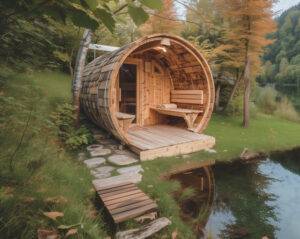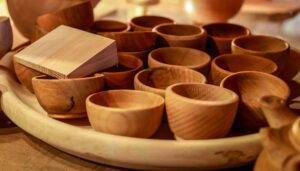Why a raised bed made of wood?
Raised beds offer many advantages in general, regardless of the material used. They allow you to grow your plants at an ergonomic height, which makes gardening easier and prevents back pain. In addition, raised beds offer better drainage and aeration properties than conventional beds on the ground.
Wood is a particularly suitable material for the construction of raised beds for several reasons. Firstly, it is a natural raw material that fits in well with its surroundings and blends harmoniously into your garden. Secondly, wood provides good insulation for the roots of your plants, which contributes to healthy growth.
Which types of wood are suitable for building a raised bed?
There are various factors to consider when choosing the right wood for your raised bed. Some popular options are larch, Douglas fir or oak.
Larch wood, for example, is characterised by its natural durability and resistance to rot. It is also relatively inexpensive and easy to work with. Douglas fir is also a good choice as it is naturally resistant to the elements.
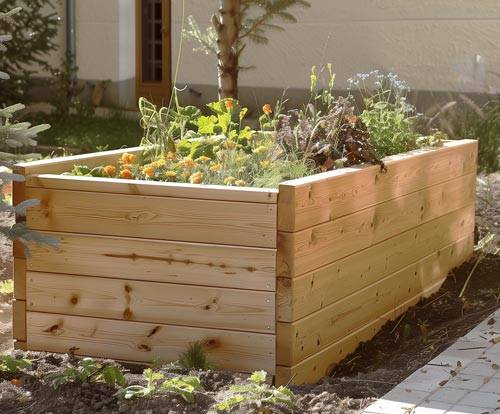
Sustainability when buying wood: tips for environmentally conscious decisions
When buying wood for your raised bed, you should pay attention to sustainability. There are various certifications and seals that can help you to identify sustainable wood. The best known of these is the FSC seal (Forest Stewardship Council) FSC seal (Forest Stewardship Council), which ensures that the wood comes from responsibly managed forests.
An alternative to tropical wood is, of course, domestic wood such as oak or beech, which often comes from sustainably managed forests. Buying regionally produced wood also reduces the carbon footprint caused by transport routes.
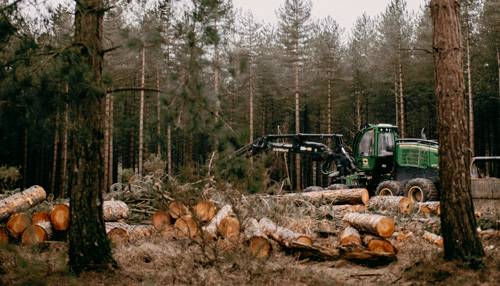
Treating wood for outdoor use: protection from the weather
To protect your wooden raised bed from the weather and extend its lifespan, it is important to treat the wood properly. One of the simplest methods is to paint the wood with a weatherproof varnish or paint.
Another option is to treat the wood with special oils or glazes to protect it from moisture and UV radiation. It is advisable to repeat the treatment regularly to maintain the protection.
Avoidance of harmful substances: Wood from organic cultivation
Organically grown wood is a good choice if you want to ensure that your raised bed is free from harmful chemicals. In contrast to conventional forestry, no pesticides or chemical fertilisers are used in organic forestry.
The difference between conventional and organic forestry also lies in the way the forest is managed. Organic forestry emphasises the preservation of natural biodiversity and the promotion of a healthy ecosystem.
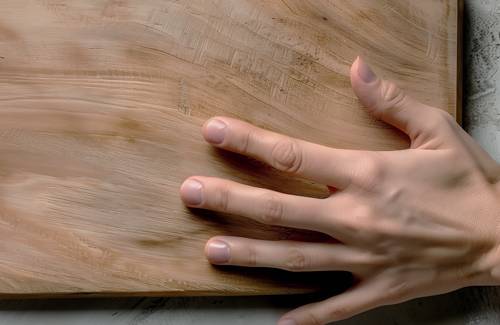
Wooden joints in raised bed construction: what techniques are there?
When building a raised wooden bed, there are various ways to join the individual parts together. A simple and popular method is of course to use screws or nails to hold the wood together.
Another option is to use tongue and groove joints or mortise and tenon joints to ensure a stable construction. Each joining technique has its advantages and disadvantages and should be selected according to the individual needs of the project.
Advantages and disadvantages of prefabricated kits compared to self-assembly
The advantage of prefabricated kits for wooden raised beds is that they contain all the necessary materials and instructions. They are generally easy to assemble and do not require any special manual skills.
DIY, on the other hand, allows you to customise the raised bed according to your individual ideas and adapt the size or shape to your needs. However, it does require more time and craftsmanship.
Tips for the care and maintenance of wooden raised beds
Regular care and maintenance is required to keep your wooden raised bed in good condition. Regularly remove weeds or dead plant debris from the bed to prevent pests.
It is also advisable to check the wood regularly for damage or signs of rotting. If necessary, you can re-treat the wood or replace damaged parts to extend the life of the raised bed.
Conclusion
A wooden raised bed offers many advantages for gardening enthusiasts. Not only does it give you an ergonomic working position in the garden, it also offers better drainage and aeration properties for your plants.
When choosing the right wood, you should pay attention to sustainability and consider certifications such as the FSC seal. Treating the wood correctly protects it from the weather and extends its lifespan.
With the right wood joints and regular care, you can create a durable wooden raised bed that will give you many years of pleasure.
FAQs
What is a raised bed?
A raised bed is a raised bed that can be built from various materials such as wood, stone or metal. It offers many advantages such as better soil aeration, protection from pests and an ergonomic working height.
Which wood is best suited for building a raised bed?
Robust and durable types of wood such as larch, Douglas fir or oak are best suited to building a raised bed. These types of wood are particularly resistant to moisture and rot.
Which types of wood should be avoided?
Wood species such as spruce or pine should be avoided, as they are not as resistant to moisture and rot as other types of wood. Wood treated with chemical substances should also be avoided as it can be harmful to plants and the soil.
How thick should the wood for a raised bed be?
The wood for a raised bed should be at least 2.5 cm thick to be stable enough. However, the thickness can vary depending on the size of the raised bed and the type of wood chosen.
Do the wooden planks for a raised bed need to be treated?
It is advisable to treat the wood for a raised bed to protect it from moisture and rot. There are various ways to treat the wood, such as with wood preservatives or natural oils.
How long does a wooden raised bed last?
Depending on the type of wood and without treatment, a wooden raised bed can last up to 10 years. However, it is important to maintain and treat the raised bed regularly to extend its lifespan.
